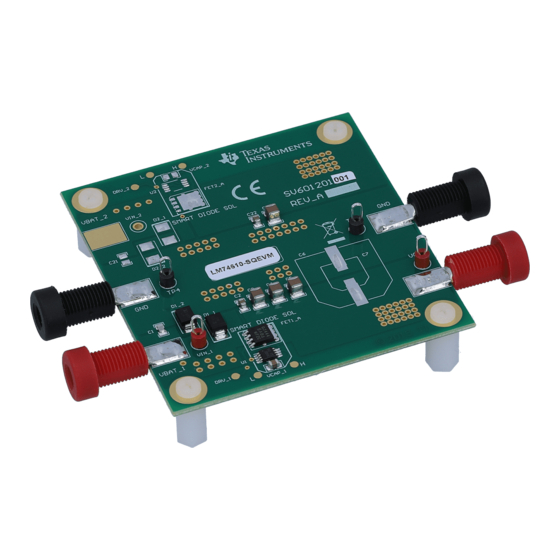
Table of Contents
Advertisement
Quick Links
Advertisement
Table of Contents

Summary of Contents for Texas Instruments LM74610-SQEVM
- Page 1 LM74610-SQEVM User's Guide Literature Number: SNVU489 October 2015...
-
Page 2: Table Of Contents
Input/Output Connector Description ....................... Board Setup ..........................Operation ..................... Reverse Polarity Protection ......................Output Voltage ........................Board Layout ......................... Schematic ........................Bill of Materials Table of Contents SNVU489 – October 2015 Submit Documentation Feedback Copyright © 2015, Texas Instruments Incorporated... - Page 3 ................Response to Reverse Polarity 12V to -20V ................... Response to Start Up Reverse Polarity ................. Periodic body diode voltage drop at the output ............... The LM74610-SQEVM Output voltage waveform ....................... Top Assembly Layer ........................ Bottom Layer .................... LM74610-SQEVM Schematic List of Tables ..................
-
Page 4: Introduction
Setup This section describes the jumpers and connectors on the EVM as well and how to properly connect, set up and use the LM74610-SQEVM. Ensure the power supply is turned off while making connections on the board. Input/Output Connector Description •... -
Page 5: Board Setup
(VBAT_1). Make sure that the external power supply source for the input voltage is capable of providing enough current to the output load so that the output voltage can be obtained. Once all connections to the LM74610-SQEVM are verified, power can be applied to VBAT_1. The EVM will then begin to operate. -
Page 6: Operation
Operation Reverse Polarity Protection A dynamic voltage pulse from +12V to -20V is applied at the VBAT_1 input of the LM74610-SQEVM. Figure 3 shows when the input voltage (yellow) drops down to -20V, the output voltage (blue) does not go negative, and therefore, the load is protected from dynamic reverse pulses at the input. - Page 7 Operation www.ti.com A -12V source is connected to the VBAT_1 input of the LM74610-SQEVM. Figure 4 shows that the Output voltage will stay at a constant 0V in this situation. This test simulates the event of connecting a 12V battery in the reverse direction, and therefore, protects the load from negative voltages.
-
Page 8: Output Voltage
DSON MOSFET ON at approximately 98% as shown in Figure 6, leading to very little overall power dissipation when compared to a typical diode. List of Tables SNVU489 – October 2015 Submit Documentation Feedback Copyright © 2015, Texas Instruments Incorporated... - Page 9 Operation www.ti.com Figure 6. The LM74610-SQEVM Output voltage waveform SNVU489 – October 2015 List of Tables Submit Documentation Feedback Copyright © 2015, Texas Instruments Incorporated...
-
Page 10: Board Layout
Board Layout www.ti.com Board Layout Figure 7. Top Assembly Layer List of Tables SNVU489 – October 2015 Submit Documentation Feedback Copyright © 2015, Texas Instruments Incorporated... -
Page 11: Bottom Layer
Board Layout www.ti.com Figure 8. Bottom Layer SNVU489 – October 2015 List of Tables Submit Documentation Feedback Copyright © 2015, Texas Instruments Incorporated... -
Page 12: Schematic
Note:The TVS+ and TVS- are not required for the LM74610-Q1. However, they are typically used to clamp the positive and negative voltage surges respectively. The output capacitors are recommended to protect the immediate output voltage collapse as a result of line disturbance. List of Tables SNVU489 – October 2015 Submit Documentation Feedback Copyright © 2015, Texas Instruments Incorporated... -
Page 13: Bill Of Materials
Test Point, Miniature, SMT Keystone 5015 Smart Diode Controller, DGK0008A Texas LM74610QDGKRQ1 Instruments VCAP_1 CAP, CERM, 2.2 µF, 50 V, +/- 10%, X5R, C2012X5R1H225K125AB 0805 SNVU489 – October 2015 List of Tables Submit Documentation Feedback Copyright © 2015, Texas Instruments Incorporated... - Page 14 STANDARD TERMS AND CONDITIONS FOR EVALUATION MODULES Delivery: TI delivers TI evaluation boards, kits, or modules, including any accompanying demonstration software, components, or documentation (collectively, an “EVM” or “EVMs”) to the User (“User”) in accordance with the terms and conditions set forth herein. Acceptance of the EVM is expressly subject to the following terms and conditions.
- Page 15 FCC Interference Statement for Class B EVM devices NOTE: This equipment has been tested and found to comply with the limits for a Class B digital device, pursuant to part 15 of the FCC Rules. These limits are designed to provide reasonable protection against harmful interference in a residential installation.
- Page 16 【無線電波を送信する製品の開発キットをお使いになる際の注意事項】 開発キットの中には技術基準適合証明を受けて いないものがあります。 技術適合証明を受けていないもののご使用に際しては、電波法遵守のため、以下のいずれかの 措置を取っていただく必要がありますのでご注意ください。 1. 電波法施行規則第6条第1項第1号に基づく平成18年3月28日総務省告示第173号で定められた電波暗室等の試験設備でご使用 いただく。 2. 実験局の免許を取得後ご使用いただく。 3. 技術基準適合証明を取得後ご使用いただく。 なお、本製品は、上記の「ご使用にあたっての注意」を譲渡先、移転先に通知しない限り、譲渡、移転できないものとします。 上記を遵守頂けない場合は、電波法の罰則が適用される可能性があることをご留意ください。 日本テキサス・イ ンスツルメンツ株式会社 東京都新宿区西新宿6丁目24番1号 西新宿三井ビル 3.3.3 Notice for EVMs for Power Line Communication: Please see http://www.tij.co.jp/lsds/ti_ja/general/eStore/notice_02.page 電力線搬送波通信についての開発キットをお使いになる際の注意事項については、次のところをご覧くださ い。http://www.tij.co.jp/lsds/ti_ja/general/eStore/notice_02.page SPACER EVM Use Restrictions and Warnings: 4.1 EVMS ARE NOT FOR USE IN FUNCTIONAL SAFETY AND/OR SAFETY CRITICAL EVALUATIONS, INCLUDING BUT NOT LIMITED TO EVALUATIONS OF LIFE SUPPORT APPLICATIONS.
- Page 17 Notwithstanding the foregoing, any judgment may be enforced in any United States or foreign court, and TI may seek injunctive relief in any United States or foreign court. Mailing Address: Texas Instruments, Post Office Box 655303, Dallas, Texas 75265 Copyright © 2015, Texas Instruments Incorporated...
- Page 18 IMPORTANT NOTICE Texas Instruments Incorporated and its subsidiaries (TI) reserve the right to make corrections, enhancements, improvements and other changes to its semiconductor products and services per JESD46, latest issue, and to discontinue any product or service per JESD48, latest issue.
- Page 19 Mouser Electronics Authorized Distributor Click to View Pricing, Inventory, Delivery & Lifecycle Information: Texas Instruments LM74610-SQEVM...











Need help?
Do you have a question about the LM74610-SQEVM and is the answer not in the manual?
Questions and answers